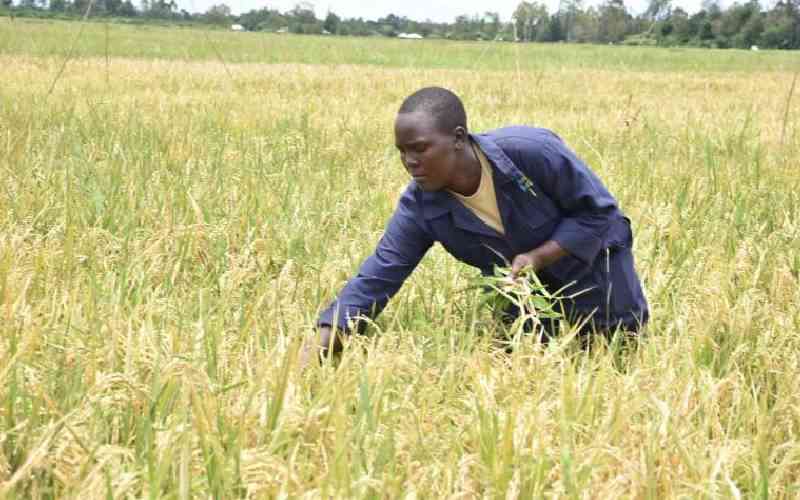By Augustine Oduor
Heart-breaking tales of farmers who have had to watch their toil turned into horrid waste, as rains set in before they harvested their grains, dominate the news last April.
Not even the threat of aflatoxin, which spreads when grains are harvested before drying up could dissuade farmers from consuming the grains.
But some farmers, as those in Ugenya, escaped nature’s wrath, thanks to modest technology and timely guidance from agricultural extension officers.
The collaborative venture between the Government and Organisation for Transforming Initiated Technologies (OTIT) was first initiated to foster better food production and health among the citizens.
Through the Ministry of Agriculture, farmers were urged to consolidate their pieces of land for maximum cultivation.
OTIT, on its part, helped farmers manage striga weed, supplied free seeds and fertiliser to farmers in line with Government’s National Accelerated Agricultural Input Access Programme.
"Under the food and health project, each household provided half an acre of land and we gave 25 kgs of fertiliser and ample seeds to farmers," explained Charles Odiero, the OTIT programmes manager said.
He said demonstration of planting and weeding was done and about 90 per cent of the families attended before venturing to their farms to prepare accordingly.
That’s when fears set in about aflatoxin putting to waste farmers’ great efforts to feed themselves, as it had in many parts of Eastern and Coast provinces.
"We have worked round the district for about five years sensitising farmers on good farming practices to eradicate striga weed. But farmers expressed fears of aflatoxin poisoning their grains," said OTIT director Immanuel Opil.
Aflatoxin is a killer disease that causes liver cancer and suppresses the immune system. It also retards growth and development in children.
Those exposed to high aflatoxin concentrations experience liver failure and death.
At least one person was reported dead after consuming contaminated maize this year, while nearly 200 people died between 2004 and 2006 after eating highly contaminated maize.
The country is currently grappling with high levels of aflatoxin contamination in maize produce.
Stay informed. Subscribe to our newsletter
So far, aflatoxin has rendered at least 2.3 million bags of maize in
Eastern and coast provinces unfit for human consumption.
But scientists have devised modest technolohgy to contain aflatoxin.
Biocontrol technology makes use of carefully selected atoxigenic strains that can safely out-run and virtually eliminate the toxic elements, effectively reducing contamination.
Biopesticide, experts say, has the ability to continue working even when the grain is in storage to ensure safety of maize.
This cost-effective method of preventing the formation of afflatoxin in maize in the field has been tries in Ugenya and could soon be implemented elsewhere.
Strains of aflavus fungus that does not produce aflatoxin were first introduced in farms. Scientists say the fungus competes, and drastically reduces the population of aflatoxin-producing strains.
"A single application of biopesticide two to three weeks before maize flowering is sufficient to prevent contamination," said Dr Ranajit Bandyopadhyay, a plant pathologist with the International Institute of Tropical Agriculture.
Farmers in Ugenya responded by saying they do not have the capacity to initiate aflatoxin preventive measures and called for help.
Last week, Cereals Growers Association CEO David Nyameino, said they had launched programmes to train farmers on post-harvesting skills to avoid loss of produce.
He said: "It has come to our attention that millions of bags (of maize) were lost in the last season due to poor handling after harvesting and we can’t allow the same to happen again this season."
His statement came barely a week after scientists launched a unique manual, the Kenya Maize Handbook, which contains management lessons, from farm preparation and planting to harvesting and marketing of food crops.
Frank Muhenga, the District Agricultural Officer said urgent measures should be taken to protect farmers’ efforts do not come to nought.
Ugenya has had consistent food shortages for the last two years, with farmers complaining of inadequate seeds and fertiliser supply. "Up to 15 bags of maize will be produced in a half an acre if factors remain constant," said Muhenda.
The food health project is funded by the Medical Research Foundation (AMREF) to the tune of Sh1.2 million.
"Five per cent of the harvests from every household would be deposited in the food bank that will be kept and sold for a good price at a later date," Odiero added.
But technology is still being approached cautiously, especially if it touches on genetically-modified grains.
Julie Girling, a member of the EU assembly’s environment committee, said if scientists see no health hazard it was right for "national governments to decide if they want to bring GMO crops in ... Any decision on whether to permit, tolerate or ban GMOs must be taken at individual national government level," she said.
 The Standard Group Plc is a
multi-media organization with investments in media platforms spanning newspaper
print operations, television, radio broadcasting, digital and online services. The
Standard Group is recognized as a leading multi-media house in Kenya with a key
influence in matters of national and international interest.
The Standard Group Plc is a
multi-media organization with investments in media platforms spanning newspaper
print operations, television, radio broadcasting, digital and online services. The
Standard Group is recognized as a leading multi-media house in Kenya with a key
influence in matters of national and international interest.
 The Standard Group Plc is a
multi-media organization with investments in media platforms spanning newspaper
print operations, television, radio broadcasting, digital and online services. The
Standard Group is recognized as a leading multi-media house in Kenya with a key
influence in matters of national and international interest.
The Standard Group Plc is a
multi-media organization with investments in media platforms spanning newspaper
print operations, television, radio broadcasting, digital and online services. The
Standard Group is recognized as a leading multi-media house in Kenya with a key
influence in matters of national and international interest.








